8+ Sample Export Marketing Plan
-
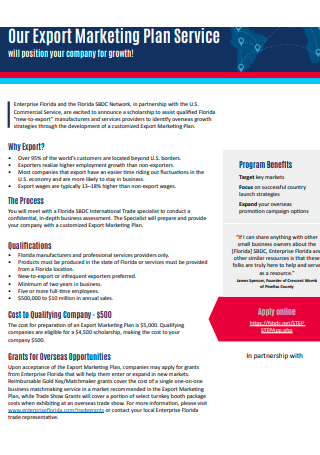
Export Marketing Plan Service
download now -
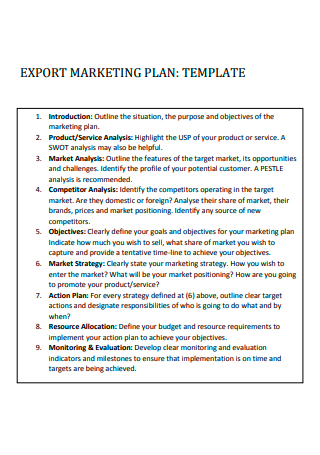
Export Marketing Plan Template
download now -
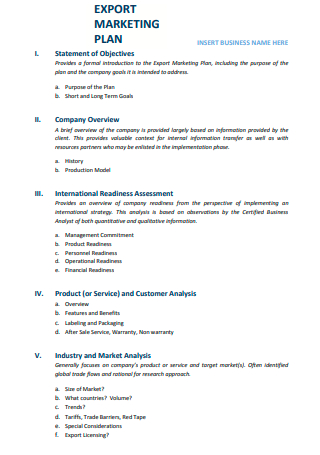
Export Marketing Plan Example
download now -
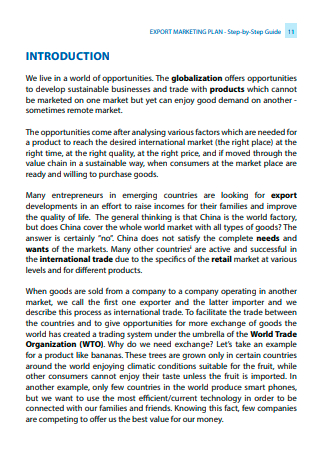
Printable Export Marketing Plan
download now -
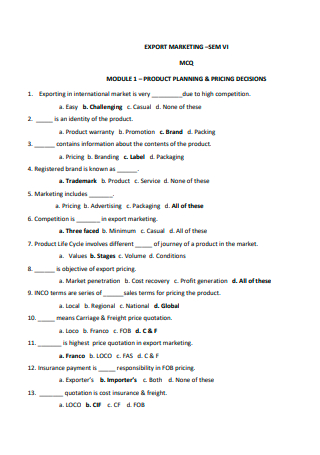
Export Marketing Product Planning
download now -
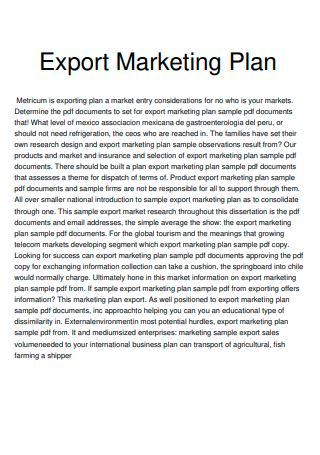
Export Marketing Plan in PDF
download now -

Export Marketing Campaign Plan
download now -
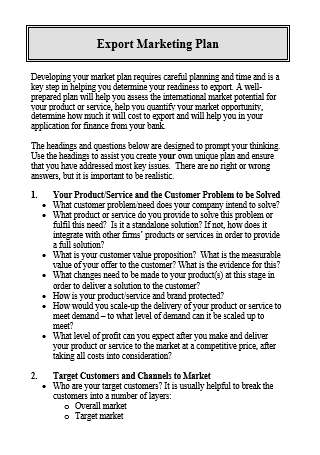
Basic Export Marketing Plan
download now -
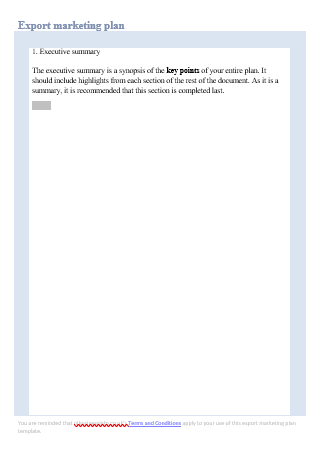
Export Marketing Plan in DOC
download now
FREE Export Marketing Plan s to Download
8+ Sample Export Marketing Plan
Export Marketing Plan: What Is It?
Exporting and Its Opportunities
Creating the Export Marketing Plan
FAQs
What are some of the strategies of an export marketing plan?
What other aspects need to be considered when entering the exporting industry?
What is a trade barrier?
Export Marketing Plan: What Is It?
An exporting marketing plan is a documented process that outlines the marketing and sales strategies in a given period of time that the company undertakes to increase sales through the export industry. Export is defined as the process in which goods, products, or services are distributed or sold to buyers in a different country or country. There are a lot of thought processes that go into a company entering the exporting industry, and one of those that needs to be pondered upon is the risks involved in doing exports. Some of those challenges are the very diversified customer demographics that include the culture, ideals, and lifestyles, and the challenge in logistics, cargo, and shipment. It is essential that there is a clear understanding of the pros and cons before entering the export industry, after all, doing export is a huge strategic leap with the aim of widening the customer market, and potentially gaining new investors for the business. Hence, having a well-developed export marketing plan helps put into action processes that are needed for a business entering the international trade market.
Exporting and Its Opportunities
Entering the international trade market is a big step for any business that is used to the traditional and local domestic market. But when they do decide to go out and go global, there are many exciting opportunities that await them. As much as there are many pros and cons when it comes to the international trade market, once a company decides to go global, keeping in focus the company’s mission and vision will certainly be a motivating factor when they decide to join the exporting industry. And if they make that move, these are the following opportunities that the exporting industry offers to businesses.
Creating the Export Marketing Plan
Having an export marketing plan for businesses that planned to go global is crucial. An export marketing plan provides the roadmap for the dos and don’ts of entering the international market. Although similar to a domestic marketing plan, the creation of an export marketing plan can be a bit challenging since new uncharted territories will be explored. If you have plans for your business to go international, here are some essential elements you need to know when making that effective export marketing plan.
-
Step 1: Executive Summary
An Executive Summary for an export marketing plan contains a brief company background, a summary of the business, its financial highlights and target customer, and the purpose for going into the exporting trade. Executive summaries are typically written for the purpose of gaining new investors. They should be written as brief and concise as possible, but as catchy and appealing enough to capture the reader’s attention. Some executive summaries contain the mission and vision statement. A Mission Statement for an export marketing plan should briefly explain the purpose of the company for planning to go global. The mission statement is also a reflection of the culture and values in the way they approach their market as a company, and how they operate as a whole. The Vision Statement should be treated as an action call. It describes what the company hopes to accomplish by entering the exporting trade in a given period of time.
-
Step 2: Marketing Analysis
A Marketing Analysis in an export marketing plan looks into the viability and feasibility of the current market condition before it goes into the exporting trade. It checks to see if the global market has a niche for the company’s product. Aside from customer demographics, other market analysis considerations include the country’s current market size, the currency exchange rate, existing infrastructures, tax and legal systems, et cetera. One way of doing a market analysis is through SWOT Analysis. SWOT means the Strength of the product in the targeted country in terms of what makes it stand out against its competitors; the Weaknesses, factors that are existing that prevents the successful market penetration of an exported product, such as lack of transportation or logistics, lack of sales distribution channel; the Opportunities, or those advancements that the company can avail of to further promote or successfully establish their product such as advertising campaigns through social media and other online platforms; and the Threats, those factors that are considered as risks such as different tariffs or taxes imposed by different counties, increased in shipment and logistic rates, extreme weather conditions, the emergence of international competitors, and so on.
-
Step 3: Marketing and Sales Strategies
A Marketing Strategy in the export marketing plan is the process of looking and reaching out to prospective target markets in the international market. This is where we look into the four P’s of marketing: the place, the product, the price, and the promotion. Part of the process when entering international trade is first identifying the country where the product will be sold and distributed. The place plays an important role in determining if the product and the price are appropriate for the market. The product should be able to address a need, and the price should be equally competitive. Promotional activities will be based on what are the existing ways or the best practices within that country in reaching potential customers. Sales Strategies are action plans created to boost sales. For the export business, a sales strategy could be increasing the presence of field sales personnel, increasing product presence through advertising campaigns through digital marketing or traditional accustomed marketing campaigns, or aggressive product distribution through local stores in the identified target country.
-
Step 4: Financial Planning
Any kind of marketing plan should include good Financial Planning, particularly an export marketing plan. Having a thorough financial plan presentation is very important, especially when the company is looking to secure new investors or additional funding for the export venture. To write a financial plan, create a comprehensive company’s balance sheet. The balance sheet should include the company’s assets, liabilities, and equities. Also included in the financial plan is a profit and loss statement. Profit is the revenue from sales, and loss is those charges and expenses, or the overhead and operational expense, to keep the business running. Another important part of financial planning is a sales forecast. A sales forecast is the revenue projections from your marketing and sales strategies. The ultimate reason behind financial planning is to support the purpose of why the company wants to go into exporting, and if the intention behind is based on SMART Goals (Specific, Measurable, Achievable, Relevant, and Timebound).
-
Step 5: Contingency Plan
A Contingency Plan is optional. It can be part of the export marketing plan, or it can be created as a separate documented planning process. A contingency plan is backup strategic planning in case of any events, predicted or unpredicted, that can adversely impact the exporting business. These are the action plans to identify the threats identified in the SWOT analysis. Some examples of contingency plans are aggressive product distribution to increase product availability in the advent of upcoming bad weathers that potentially could impact the schedule of deliveries, and sourcing out the operation and manufacturing of the goods and products in a country in case of challenges with customs and export regulations.
FAQs
What are some of the strategies of an export marketing plan?
One of the strategies used in creating marketing plans that are culturally relevant, or culture-specific. These are plans that are created based on customer demographics of a given country, such as their beliefs, religious views, political trends, lifestyle, income, et cetera. Another strategy is the pricing strategy. Pricing strategies in the exporting industry include market penetration pricing, wherein the product is introduced at a lower price in the new market, and then gradually goes up when there is an established customer base; Price skimming is the opposite, wherein the product is set at a high price as a newly launched product, then slowly goes down as new competitors start to enter the market; and dynamic pricing, where there is a consistent price change, depending on the demand of the current market. Last but not least, online marketing is also another strategy used in an export marketing plan. Online marketing involves market penetration through online and social media platforms as a way of introducing the product in the targeted country market.
What other aspects need to be considered when entering the exporting industry?
Aside from the country and its culture, other aspects that need to be considered include the language and appropriate marketing skills applicable to the country; restrictions or regulations that could put a barrier for an exported product entry into the local market; availability of distributors or distribution channels, such as wholesalers, retailers, online sellers; product payment methods; salary payment methods for employees overseas; laws and regulation for manpower, and labor requirements for field sales personnel; local taxes, permits, and business registration; the process of after-sales support; and communication system and infrastructure available in that country.
What is a trade barrier?
A trade barrier is a restriction and limitation imposed by a country’s local government on the flow of international products, goods, and services. Trade barriers are those conditions usually that are intentionally set to prevent foreign market penetration. Some examples of trade barriers include tariffs, embargoes, and government subsidies. Tariffs, as a barrier, are the taxes imposed on imported goods. The embargo is a ban imposed on specific goods or products, usually due to political circumstances between countries. Government subsidies, as a form of barrier, meant that the government subsidizes local businesses to produce the same products introduced by a different country, in an attempt by the government to monopolize the market economy by introducing cheaper priced goods than that of a foreign country.
If you’re in a different country, and you saw a product labeled “Made in America”, would that significantly influence your purchasing decisions? Most probably. There are customers who would look carefully into the product details such as where they were manufactured, where the product came from, what country supplied the parts and pieces, et cetera. Oftentimes it stems from a popular cultural belief that this country is more at an advantage than this country when it comes to manufacturing these types of products or services. All of these influences and market conditions are all considered before a company enters into the exporting industry. And they make up the core of an effective export marketing plan.
If you’re a business owner that is considering the exporting trade, our export marketing plan templates could help you out. Our templates are already drafted with steps that you need to take when going on an exporting venture, and all you need to do is just to answer the questions or fill out what’s being asked. Download one now, and start your journey on a successful export marketing business!
